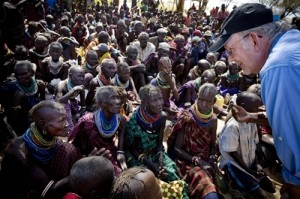Situation in Horn of Africa set to get worse for millions of children
2011-07-17
NAIROBI, Kenya/ HONG KONG, 17 July 2011 – UNICEF has called for an immediate expansion of assistance across the Horn of Africa’s drought affected communities, to address the dire needs of more than 2 million children, of whom half a million are at imminent risk of dying. With no improvement in the overall food security conditions expected before early 2012 the already severe nutrition situation will likely worsen further.
| “What we are seeing here is almost a perfect storm – conflict in Somalia, rising fuel and food prices, and drought and the loss of the rain. Now we are going to go another four to five months before there will be a harvest and we all have a huge job ahead,” said UNICEF Executive Director Anthony Lake at the end of a four-day mission to Kenya. “In many of the poorest communities people are either too poor or too weak to be able to try to walk for help.” |  |
During a field mission to the arid region of Turkana in northern Kenya, Lake saw the silent face of the crisis. He met with pastoralists whose livestock had been decimated by the consequences of a ten-year drought. Malnutrition rates in some parts of Turkana have skyrocketed to 37 per cent. At a meeting in Kapua village, a satellite point for food distribution, hundreds of once nomadic herders, gathered to share their experiences and asked not to be forgotten. While safety nets and humanitarian assistance helped sustain these communities in the past, the eakdown of the food pipeline means that supply is now sporadic and inadequate.
Lake heard from women who have to walk from dawn to midday in search for water in dry river beds. He heard how children were surviving if lucky on one meal a day, comprised often only of palm nuts, and lactating mothers did not produce enough milk to feed their newborns.
It is a situation that had been replicated in other communities across the semi-arid and arid areas of Kenya, Ethiopia, Djibouti, and Somalia. “This is not just a question about lives being threatened but a way of life being threatened,” he said. In Somalia, hundreds of thousands of children and their families were already on the move to seek assistance either within camps for internally displaced people or flowing across the border into neighboring countries.
 |
Lake pledged UNICEF’s continued support, stressing that the international children’s agency would continue working closely with partners to scale up an emergency response in the region, which has been underfunded for many years. He called on the international community and private donors alike to step up funding for UNICEF, WFP, UNHCR and other partners, and to focus new effort on finding solutions that address the deep-seated poverty and vulnerability in the region. |









